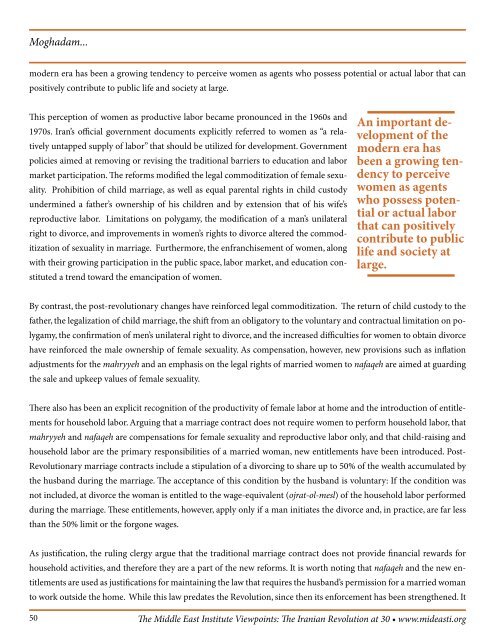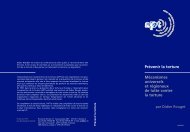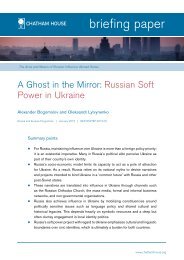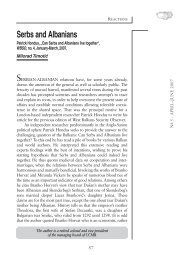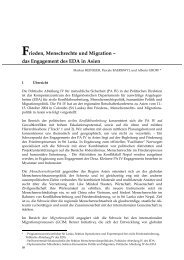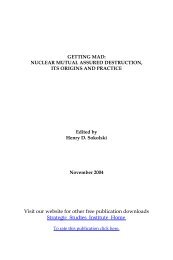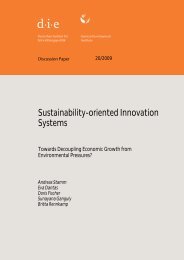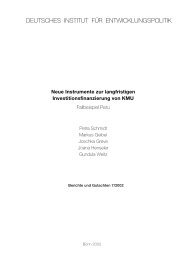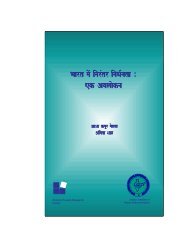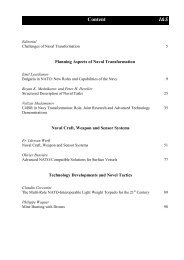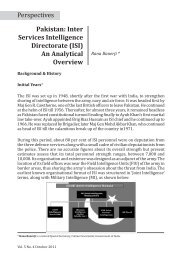The Iranian Revolution at 30
The Iranian Revolution at 30
The Iranian Revolution at 30
You also want an ePaper? Increase the reach of your titles
YUMPU automatically turns print PDFs into web optimized ePapers that Google loves.
Moghadam...<br />
modern era has been a growing tendency to perceive women as agents who possess potential or actual labor th<strong>at</strong> can<br />
positively contribute to public life and society <strong>at</strong> large.<br />
This perception of women as productive labor became pronounced in the 1960s and<br />
1970s. Iran’s official government documents explicitly referred to women as “a rel<strong>at</strong>ively<br />
untapped supply of labor” th<strong>at</strong> should be utilized for development. Government<br />
policies aimed <strong>at</strong> removing or revising the traditional barriers to educ<strong>at</strong>ion and labor<br />
market particip<strong>at</strong>ion. <strong>The</strong> reforms modified the legal commoditiz<strong>at</strong>ion of female sexuality.<br />
Prohibition of child marriage, as well as equal parental rights in child custody<br />
undermined a f<strong>at</strong>her’s ownership of his children and by extension th<strong>at</strong> of his wife’s<br />
reproductive labor. Limit<strong>at</strong>ions on polygamy, the modific<strong>at</strong>ion of a man’s unil<strong>at</strong>eral<br />
right to divorce, and improvements in women’s rights to divorce altered the commoditiz<strong>at</strong>ion<br />
of sexuality in marriage. Furthermore, the enfranchisement of women, along<br />
with their growing particip<strong>at</strong>ion in the public space, labor market, and educ<strong>at</strong>ion constituted<br />
a trend toward the emancip<strong>at</strong>ion of women.<br />
An important development<br />
of the<br />
modern era has<br />
been a growing tendency<br />
to perceive<br />
women as agents<br />
who possess potential<br />
or actual labor<br />
th<strong>at</strong> can positively<br />
contribute to public<br />
life and society <strong>at</strong><br />
large.<br />
By contrast, the post-revolutionary changes have reinforced legal commoditiz<strong>at</strong>ion. <strong>The</strong> return of child custody to the<br />
f<strong>at</strong>her, the legaliz<strong>at</strong>ion of child marriage, the shift from an oblig<strong>at</strong>ory to the voluntary and contractual limit<strong>at</strong>ion on polygamy,<br />
the confirm<strong>at</strong>ion of men’s unil<strong>at</strong>eral right to divorce, and the increased difficulties for women to obtain divorce<br />
have reinforced the male ownership of female sexuality. As compens<strong>at</strong>ion, however, new provisions such as infl<strong>at</strong>ion<br />
adjustments for the mahryyeh and an emphasis on the legal rights of married women to nafaqeh are aimed <strong>at</strong> guarding<br />
the sale and upkeep values of female sexuality.<br />
<strong>The</strong>re also has been an explicit recognition of the productivity of female labor <strong>at</strong> home and the introduction of entitlements<br />
for household labor. Arguing th<strong>at</strong> a marriage contract does not require women to perform household labor, th<strong>at</strong><br />
mahryyeh and nafaqeh are compens<strong>at</strong>ions for female sexuality and reproductive labor only, and th<strong>at</strong> child-raising and<br />
household labor are the primary responsibilities of a married woman, new entitlements have been introduced. Post-<br />
<strong>Revolution</strong>ary marriage contracts include a stipul<strong>at</strong>ion of a divorcing to share up to 50% of the wealth accumul<strong>at</strong>ed by<br />
the husband during the marriage. <strong>The</strong> acceptance of this condition by the husband is voluntary: If the condition was<br />
not included, <strong>at</strong> divorce the woman is entitled to the wage-equivalent (ojr<strong>at</strong>-ol-mesl) of the household labor performed<br />
during the marriage. <strong>The</strong>se entitlements, however, apply only if a man initi<strong>at</strong>es the divorce and, in practice, are far less<br />
than the 50% limit or the forgone wages.<br />
As justific<strong>at</strong>ion, the ruling clergy argue th<strong>at</strong> the traditional marriage contract does not provide financial rewards for<br />
household activities, and therefore they are a part of the new reforms. It is worth noting th<strong>at</strong> nafaqeh and the new entitlements<br />
are used as justific<strong>at</strong>ions for maintaining the law th<strong>at</strong> requires the husband’s permission for a married woman<br />
to work outside the home. While this law pred<strong>at</strong>es the <strong>Revolution</strong>, since then its enforcement has been strengthened. It<br />
50 <strong>The</strong> Middle East Institute Viewpoints: <strong>The</strong> <strong>Iranian</strong> <strong>Revolution</strong> <strong>at</strong> <strong>30</strong> • www.mideasti.org


